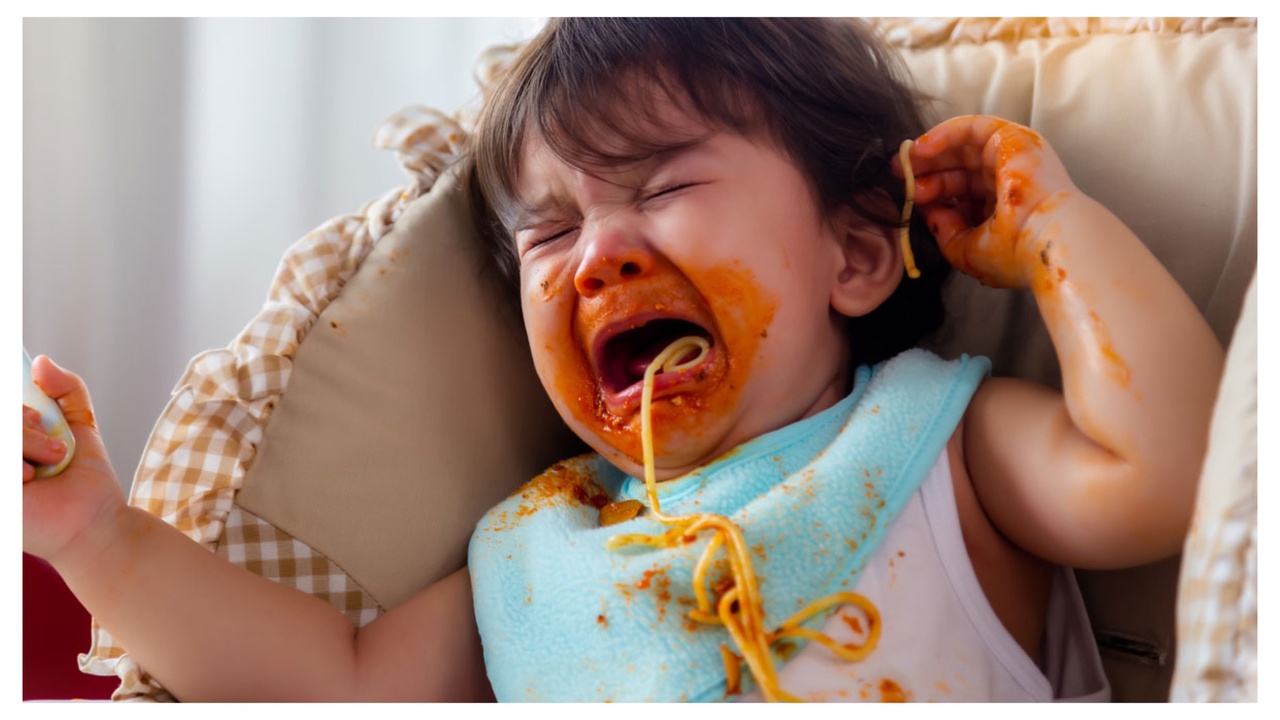
Feeding Toddlers - What's Normal? Mealtime Problems & Solutions
toddler
tod·dler /ˈtädlər/ - noun : A small, toddling, developing human that has the capacity to make parents experience feelings ranging from explosive love and adoration to annoyance and exasperation; all in equal measure; all within minutes….and especially during mealtimes.
All day, every day parents ask me to explain the “WHYYYYY!!!???” of their child’s mealtime behaviours. Yes, many of the children that I see in my practice are demonstrating mealtime challenges and behaviours associated with Pediatric Feeding Disorder (PFD); however, often they are just behaving like typical toddlers. When your child has a feeding issue, it can be difficult to untangle the difference between typical and atypical toddler feeding behaviours.
After 22-years of as a Feeding Therapist and having raised two terrible (but totally terrific) toddlers. I present you with my list of what I consider to be typical (“normal”) toddler mealtime behaviours (along with my tips to help):
1. Loving a food, then hating a food
On some weeks, there was not enough cheese on earth to make my daughter happy. I would call this a “cheese week”. The next week, she would look at cheese as though it was the most disgusting thing she had ever seen, as though I was offereing her fried maggots, and and would throw all of the cheese on the floor. I would therefore call this a “non-cheese week.”
What to do: Put the food away for a week or two, then re-introduce it. Your child may just need a vacation from the food. This can break the refusal pattern and your toddler may start accepting the food again.

2. Not eating as much as when they were under 12 months
After 12-months, a child’s growth slows down. Between 1-5 years of age, many children normally gain only 4-5 pounds each year. Because they are not growing as fast, they need fewer calories, and they seem to have a poorer appetite. Remember not to push/force your child to eat…it’s normal for intake to decrease as they enter toddlerhood.
What to do: Respect your child’s hunger and satiety cues. Never push or force your child to eat, as this will only increase refusal. Here are some additional tips to help: Tips to Tackle Mealtime Power Struggles
3. Toddler throwing foods
Yup. Just for the sheer joy of it…just to watch it go splat…and especially just to watch the expression on your face! My son Thomas used to make absolutely, 100%, undoubtedly sure that he had my full attention, then he would throw his food straight at the kitchen wall...then he’d smile from ear-to-ear...an evil, satisfied little smile.
What to do: Behaviour Management 101: Ignore. To reduce or eliminate a behaviour, ignore it. To increase a behaviour, reinforce it. By telling your child “No!” or “Stop throwing!” you may be accidentally reinforcing this behaviour. If you completely remove your attention, your child will soon learn that they get no attention for throwing.
4. Throwing cup / Sticking fingers in liquids in the cup / Dumping the liquid / Crying because they dumped the liquid on themselves…all on purpose.
Yes. Yes. Yes. and Yes!
What to do: If your child is touching liquid in the cup to learn what’s inside and explore with their senses, this is fine. If you child is just pouring or dumping the liquid, remove the cup and try reoffering it after a little break. You can calmly say, “The cup is for drinking.”

5. Wanting to self-feed
“Myyyyy do!!!” was my son’s favourite phrase every time I offered a utensil or piece of food toward his mouth.
What to do: Encourage independence! This a good thing. Give your child their own bowl and utensils and allow self-feeding. Here are some additional tips: Encouraging Toddler Self-Feeding.
6. Toddler wants to feed you (but not themselves)
This too is a good thing. When kids feed others, they are learning. They watch how you accept and chew the food. They learn through your modeling. When you model enjoyment of foods, this may help your child to eventually accept the food themselves.
What to do: If your child only wants to feed you and is overly distracted and not self-feeding, you can re-direct by saying “I’m all done.” “Your turn”.
7. Wants the food off your plate but not their own
Toddlers often won’t touch anything on their own plate, but insist on eating the exact same food that they have been offered off other people’s plates.
What to do: Intially it’s ok to let you child sample foods from your plate, as they may help them to accept new foods; however, over time it’s important for your child to learn to eat from their own plate. Redirect your child by saying “This is Mommy’s food.” “Here are your carrots.”
8. Eating from wrong side of the utensil
You load one-side with food, your toddler flips it around and puts the empty end in their mouth. Toddlers are smart little humans and they want to feel a sense of control.
What to do: Try loading both sides! Aha! Or just leave your child to figure this one out in their own time. Keep the pressure low and remember to ignore refusal behaviours.
9. Toddler obsessed with condiments
- Licking all the peanut butter off toast, but not eating the toast
- Dipping and licking all the ketchup off fries, but not eating the fries
What to do: Just model your own enjoyment of foods. Demonstrate how you dip the food, then take a bite. Don’t pressure your child. Over time reduce the amount of ketchup you are offering so your child learns to eat more of the food versus the condiment.
10. Playing with food
As I’ve mentioned many times in my previous blogs, toddlers learn through play so playing with food is a great way for your child to learn to accept new foods. Here is some information about the benefits of food play: Benefits of Food Play Food play allows kids to explore with all their senses. Your child may love swirling purees around on the tray, stacking foods, or putting foods in and out of containers. It’s all good! The more your toddler looks, touches, smells, and squishes food, the more likely that the food will be eaten in time.
What to do: If you are trying to introduce new foods to your picky eater, try to set aside some time each week, outside of mealtimes, where you and your child can “play with” and explore new foods. Here’s a link to some ideas for food play activities for toddlers: Food Play Ideas. If your child is playing too much during a mealtime and not eating their food, this may be a signal that they are not hungry or interested. I would suggesting offer one other food and if your child continues to refuse, then end the meal.

11. Bothered by tiny crumbs/bits
Toddlers have mad skills when it comes to sorting out food textures in their mouth. They can detect the tiniest change in texture in their mouth and keep the preferred food in their mouth while spitting out the bits. I once observed a child eating a cupcake and individually sorting and spitting-out each teeny tiny piece of sprinkles while chewing and swallowing the cake and icing. Like I said, mad skills!
What to do: It’s completely up to your child if they want to accept certain foods and textures….just don’t stop offering. In time and with repeated exposure your child will learn to accept a variety of textures including teeny tiny bits. You can try sprinkling a few crumbs, wheat germ, or ground nuts/flax on your child's food to help them gradually get used to little bits of texture.
12. Taking only one bite of each food
“Yep…that's right Mom....just sampling everything today. I’m done”.
What to do: Toddlers have an attention span of about 10 minutes, so offer foods in courses. In my years of practice, I have found that toddlers will sit a bit longer and eat a bit more volume if you don’t play all your cards at once. Offer 3-4 foods over the course of a meal, 1 food at a time. Start with the foods that you would most like your child to eat, as they are most likely to accept this at the start of the meal when they are hungry. If your child begins to refuse the food, remove it, and offer the next course. A new course can create new interest and encourage continued eating.
13. Smearing food in their hair
May I remind frustrated parents that many hair products that we purchase as adults, proudly advertise the benefits of food-based beauty products – avocado shampoo, peach conditioner....look on the bright side ;)
What to do: Again, if your child is engaged and participating in sensory exploration with food, let them learn. If they appear to be finished eating and are just bored, remove the food and end the meal.

14. Toddler spitting foods
This can be a normal step in learning to accept new foods and textures. There’s nothing scarier than having a food in your mouth that you don’t like the feeling of and not being able to get it out. I coach parents that it’s ok if their child needs to spit foods out while they are learning to chew and tolerate a new texture and flavour.
What to do: As above...just ignore this behaviour and remain neutral. Remind yourself that it’s normal for toddlers to spit-out some food when they are learning to accept it. Avoid drawing attention to this behaviour as you may accidentally reinforce it. Todder thinks, “I get a lot of attention from Dad when I spit-out my food, so I think I will do it more!”
15. Toddler won't eat the food because you cut it
They want the WHOLE ENTIRE THING. The whole apple. The whole slice of bread. As soon as you cut it into pieces…enter meltdown and refusal. "How dare you cut my apple?!"
What to do: Present the food in different ways. You can let your child have a large piece or a whole slice of bread, but also offer sticks and other shapes to expand their horizons and increase their acceptance of foods prepared different ways.
16. Only eat 1 colour of food or 1 shape of food
Toddlers can be finicky little creatures. For a few months during toddlerhood my son would only accept foods that were cut into long skinny strips and placed in a cup. He called every type of food “Fwench fwies”. I would say, “Here you go…apple French fries”, “chicken French fries”, “cheese French fries” as I presented each food cut into “French fry’ shapes.
What to do: As above. Go with the flow, but as I mentioned, try to present foods in different ways so your child doesn’t get too stuck on one shape or type of food.
17. Toddler skipping meals
This one really stresses parents out. Especially when your child has a history of feeding issues, food refusal, and/or poor growth. Please try to remember that it's normal for toddlers to sometimes skip a meal or have a poor intake day, especially if they are tired, teething, or distracted. It’s also normal for toddlers to eat different amounts day-to-day and meal-to-meal.
What to do: Respect your child’s hunger/satiety cues. If you have tried offering a couple of foods and your child is refusing, end the meal and wait until the next scheduled feeding time.

18. Refusing to go into their highchair
My son would do the famous straight leg lock so I couldn’t get him into his chair. He would not bend. Literally. Why? Toddlers want to play. Their main purpose in life is to play. Eating is secondary to play. Taking them away from play and putting them in their chair can lead to tantrums. Visit my previous blog for tips to help with Toddler Mealtime Power Struggles.
What to do: Make sure the meal is ready to go and have a preferred food on the tray! Avoid bringing your toddler to a highchair with nothing on the tray. Also try offering a “transition food” in your toddler's hand when moving from playing to mealtime. Let your child hold a piece of toast in their hand and bring it to the highchair to start the mealtime.
19. Uh oh...wrong coloured plate
Oh no…you didn’t? Offering your child the blue plate when they had envisioned the orange plate could result in tantrums and plate throwing of epic proportions.
What to do: Try not to let your child exercise too much control as you will end-up facing mealtime power struggles. Having said that, try not to make life too hard on yourself and pick your battles. Perhaps offer both plates so you child learns that they are ok with either and you are not going to always give-in to their requests.
20. Toddler stuffing their mouth
Many toddlers stuff their mouth. Sometimes they are really enjoying their food and they want to pull ALLLLLL of it in their mouth at once. Other times they want to make sure that no-one else gets any or they want to eat quickly so they can get back to their number one priority – PLAYING! (see above).
What to do: Toddlers need to learn to regulate themselves. When they overstuff their mouth they learn how much food to put in their mouth at once and how to get it out. Having said that, if your toddler is over-stuffing and gagging/choking, I suggest pacing them by placing 1-2 pieces on the tray at a time. In time your child will slow down and follow this pace when self-feeding.
21. Eating from the floor, but not tray
My daughter would throw most of her foods off her tray. When I felt that she didn’t want to continue eating, I would respect her cues and end the meal. As soon as I took her out of her highchair she would crawl around on the floor and eat all of the foods she just refused. Whaaaat!!!???? Whhhyyyy!!!??
What to do: Don’t allow this, as it’s not a good pattern. Remove the food and your child and simply state, “We eat when we are sitting in the chair.” If you allow your child to snack on foods after refusing the meal, they will learn that they don't need to eat during mealtimes.
22. And....last (but not least frustrating)...a toddler's fave word – "NO!"
Toddlers LOVE this word. They have figured out how to establish their independence.
What to do: Avoid yes/no questions at mealtimes. Instead of saying, “Do you want carrots?”, try, “Do you want the carrots in your bowl or on the tray?”. Instead of saying, "Do you want to eat?" state "It's eating time!"

I wrote this blog to provide readers with information about “typical” toddler mealtime behaviours and how to respond. Things get more complicated when your child has feeding issues (e.g., developmental delays, extreme picky eating, delayed mouth muscle skills, or sensory processing issues). Parents find it difficult to distinguish between a feeding disorder and “normal” toddler behaviours. If you have tried the above “What to do” tips and you are continuing to struggle with your toddler's feeding, I suggest you seek help from a qualified Feeding Therapist. If your toddler is not growing well or mealtimes continue to be stressful due to refusal and poor intake, then it’s important to rule-out any underlying issues and place your child on the path to positive eating as soon as possible.


